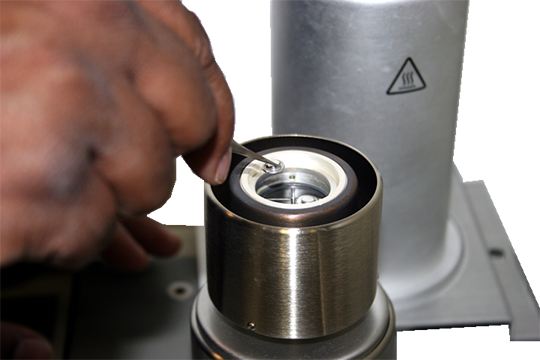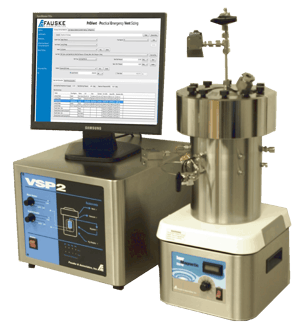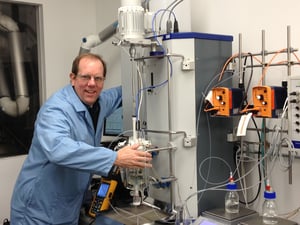How a Thermal Hazards Testing and Calorimetry Services Lab Can Help
Ken Kurko, Chief Technology Officer, Fauske & Associates
A full service, state of the art thermal hazards laboratory continuously adds various pieces of instrumentation. As an engineering consulting firm, we are challenged, every day, with unique testing and consulting requests that makes having a variety of equipment at our disposal advantageous. Listed below, you will find descriptions of our most commonly used testing techniques to characterize thermal hazards.
Differential Scanning Calorimetry (DSC)
 |
| DSC Test Cell |
Differential Scanning Calorimetry is a technique in which the difference of energy inputs (heat flow) required to keep a substance and a reference material at the same temperature is measured as a function of temperature while the sample and reference material are subjected to a controlled heating program. The DSC is a good screening tool for evaluating the thermal stability of homogeneous materials at temperatures ranging from -90°C to 500 °C. This piece of equipment evaluates milligram size samples and therefore is not always appropriate for heterogeneous mixtures as sampling can become an issue. In addition to screening tests, the DSC can be used to perform several ASTM test methods.
- Thermal Stability of Chemicals (ASTM E537)
- Arrhenius Kinetic Constants (ASTM E698)
- Enthalpies of Fusion and Crystallization (ASTM E793)
- Melting and Crystallization Temperatures (ASTM E794)
- Purity Evaluations (ASTM E928)
- Specific Heat Capacity (ASTM 1269)
- Glass Transition Temperatures (ASTM 1356)
- Oxidation Induction Time of Hydrocarbons (ASTM 1858)
- Oxidation Onset Temperature of Hydrocarbons (ASTM 2009)
- Estimating Kinetic Parameters Using the Borchardt and Daniels Method (ASTM E2041)
- Kinetic Parameters Using Isothermal Methods (ASTM 2070)
- Heat of Reaction of Thermally Reactive Materials (ASTM 2160)
Thermogravimetric Analysis (TGA)
Thermogravimetric analysis is used to monitor changes in weight as a function of temperature. At Fauske & Associates (FAI), we have traditional TGAs as well as an instrument that is capable of measuring weight changes and heat flow simultaneously and is, therefore, referred to as an SDT, or Simultaneous DSC-TGA. The added ability to monitor heat flow is especially useful for determining if the weight change is associated with either an endothermic or exothermic reaction. Like the DSC, these instruments are used to evaluate milligram size samples and are best suited for homogeneous mixtures. However, the TGA is capable of evaluating materials at temperatures ranging from ambient to 1400°C. The following is a list of ASTM test methods that can be performed using this equipment:
- Compositional Analysis (ASTM E1131)
- Decomposition Kinetics (ASTM E1641)
- Loss-on-Drying (ASTM E1864)
- Calculating Thermal Endurance of Materials (E1877)
- Volatility Rate (ASTM E2008)
- Thermal Stability (ASTM E2550)
Accelerated Rate Calorimetry (ARC)
The ARC provides thermal hazard evaluation of products, reaction mixtures, and intermediates. The experimental results are used for reactor and pilot plant safety analysis. It determines the relationship between time, temperature, and pressure for exothermic reactions. Testing is conducted following ASTM standard E 1981, “Standard Guide for Assessing the Thermal Stability of Materials by Methods of Accelerating Rate Calorimetry.” Thermal and pressure hazard parameters related to ARC data include:
- Heat generation rates
- Onset temperature
- Decomposition temperature of the mixture
- Adiabatic temperature rise
- Pressure generation rate
- Time to maximum rate
- Temperature of no return
- Self-accelerating decomposition temperature
Isothermal Microcalorimetry
At FAI, we use a Thermal Activity Monitor (TAM), which is an isothermal microcalorimeter designed to monitor a wide range of chemical and biological reactions for this type of testing. The instrument can quantify exothermic and endothermic processes at a chosen test temperature between 5 and 90°C. Through the use of a sophisticated heat leakage principle, the TAM is capable of measuring heat flows as low as 0.1 µW. Because of its sensitivity, it is often use to study reactions that traditional calorimeters such as the DSC, ARC, or the Vent Sizing Package 2 (VSP2TM) cannot. The TAM is commonly used in the following studies:
- Kinetics of Chemical Reaction
- Activation Energy
- Rate Law
- Autocatalytic Behavior
- Chemical Transportation and Storage
- Assure Safe Transport- Self Accelerating Decomposition Temperature
- Quantify Shelf Life
- Biological Reactions
- Evaluation of Fermentation Rates
- Metabolism of Living Systems
- Compatibility Studies
- Oxidation or Corrosion Rates
- Interaction Tests
 |
|
VSP2 with FAI Prevent Software |
Adiabatic Calorimetry
FAI utilizes two types of low thermal inertia adiabatic calorimeters: the Vent Sizing Package 2 (VSPTM) and the Advanced Reactive Systems Screening Tool (ARSSTTM). Adiabatic data obtained from these instruments can be used to characterize reactive chemical systems and consequences that could occur due to process upset conditions. These data include adiabatic rates of temperature and pressure change which, due to the low thermal inertia, can be directly applied to process scale to determine relief vent sizes, quench tank designs, and other relief system design parameters related to process safety management. Depending on the instrument and configuration, our adiabatic calorimetry techniques can but used to directly simulate process conditions including:
- Loss of cooling or agitation
- Accumulation or mischarge of reactants
- Contamination of batch
- Thermally initiated decomposition
- Resident incubation time
- In-situ liquid/gas dosing or sampling
- Many testing configurations
- Solids, liquids or two phase mixtures
- Closed or open (vented) tests
- Scaled blowdown simulation
- Test cells are available in 304 & 316 SS, Hastelloy C, Titanium and glass
 |
|
Dr. Donald Knoechel at the RC1 |
Reaction Calorimetry
Traditionally, we have focused our testing efforts toward helping our customers understand how their chemical system responds to a given upset scenario – preparing for the unexpected. We added equipment that can help our customers quantify the heat released during their intended chemical reactions – preparing for the expected. Information obtained from reaction calorimetry experiments is especially crucial when scaling up from lab to plant. In our labs, we utilize two main instruments to conduct these studies: the Mettler-Toledo RC1, a heat flow calorimeter, and the Chemisens CPA 202, a heat flux calorimeter. With these two instruments we can design experiments that mimic a wide variety of plant process conditions and procedures. Additionally, we have a THT µRC which allows us to perform small scale reaction calorimetry experiments and also investigate potential chemical compatibility issues of binary systems.
We recognize that generic solutions to process safety are often not practical for our customers as they have unique systems with unique problems. Our extensive list of instruments combined with our experienced staff, enables us to provide our customers with solutions that address their specific process safety concerns. For more information, to request a quote or discuss your specific application please contact thermalhazardsgroup@fauske.com, or Ken Kurko at 630-887-5266 or kurko@fauske.com. And for more thought leadership content in the areas of process safety, industrial testing, and more, subscribe to our blog.

